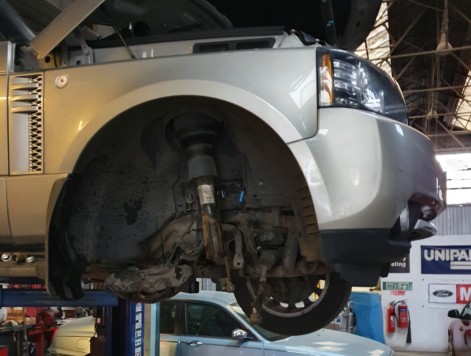Experiencing hesitation and restricted performance in your vehicle, especially under hard acceleration? You might be encountering the frustrating P0087-00 fault code, indicating low fuel rail pressure. This article dives into a real-world DIY repair journey, focusing on diagnosing and resolving this issue, particularly in high-performance vehicles where fuel delivery is critical.
The original problem presented itself as a disconcerting hesitation when accelerating, especially at wide open throttle above 4000rpm. This would often trigger a “restricted performance” mode. Cycling the ignition would temporarily clear the issue, only for it to return under similar driving conditions. Interestingly, the fault was intermittent, sometimes throwing the P0087-00 “low fuel pressure” code, and other times leaving no stored fault codes despite the performance issues.
Initial diagnostic steps, following standard procedures for a P0087-00 code, focused on common culprits within the fuel system. These checks, often suggested by manufacturers like JLR (Jaguar Land Rover), include:
- Fuel Leak: Inspecting the fuel system for any visible leaks.
- Crushed Fuel Pipe: Checking the fuel lines for obstructions or damage.
- Fuel Filter: Examining and potentially replacing the fuel filter.
- Fuel Rail Pressure Sensor: Testing or replacing the fuel rail pressure sensor.
- Lift Pump (In-Tank): Assessing the in-tank fuel pump’s functionality.
Despite thorough checks and even replacements of some of these components, the problem persisted. Frustration mounted as the usual suspects were ruled out, leaving the root cause elusive.
Seeking solutions beyond the standard diagnostic paths, online forums, specifically those dedicated to Jaguar vehicles, provided a crucial breakthrough. A search revealed several instances of similar P0087-00 symptoms and fault codes being resolved by replacing the high pressure mechanical fuel pumps. This component, surprisingly absent from the initial JLR diagnostic workflow for P0087-00, emerged as a likely culprit.
For vehicles equipped with high-performance engines, like those mentioned in the original scenario, high-pressure fuel pumps are essential for delivering the required fuel volume, especially under demanding conditions. These pumps, typically mechanically driven, can degrade over time or fail, leading to insufficient fuel pressure at higher engine speeds.
The parts required for this repair were identified as:
- JLR Part Number: LR011308 (High Pressure Fuel Pump)
- Bosch Part Number: 0 261 520 045 (Manufacturer of the pump)
These part numbers cross-reference with other numbers like 8W93-9D376-AE, 0 261 520 046, HDP-5-PE, AJ812357, and C2Z22287, indicating compatibility across various models and potentially other vehicle brands using Bosch fuel systems.
The repair process, while not overly complex, was described as time-consuming, taking around nine hours for a first-time attempt. A key challenge lies in accessing the high-pressure fuel pumps, which are typically located on the engine block. The chosen approach involved removing the off-side front (O/S/F) drive shaft assembly to gain sideways access. This method, while requiring disassembly, was deemed preferable to attempting a blind removal from the top, which often involves alternator removal and limited visibility.
To facilitate drive shaft removal, the entire hub, suspension arms, and shaft were removed as a single unit after detaching the brake disc and caliper.
 Location of high pressure fuel pumps on engine block for P0087-00 repair
Location of high pressure fuel pumps on engine block for P0087-00 repair
Image showing the location of the rear high-pressure fuel pump (red) and front high-pressure fuel pump (yellow) on the engine block, crucial for P0087-00 diagnosis and repair.
With the drive shaft assembly removed, access to the starter motor and associated wiring became possible, allowing removal of the rear high-pressure fuel pump. However, removing the front pump presented another hurdle. Clearance issues with the steering rack required unbolting the anti-roll bar (ARB) from the opposite side and partially detaching the steering rack to create just enough space for pump removal.
Reassembly was a reversal of the disassembly process. Importantly, engine oil was drained prior to pump removal to prevent leakage from the pump mounting holes on the engine block. These pumps are mechanically driven by a dedicated camshaft connected to the crankshaft. New engine oil and filter were installed, power steering fluid and front differential fluid were topped up.
The result of the high-pressure fuel pump replacement was a complete resolution of the P0087-00 fault and associated performance issues. Initial testing confirmed smooth acceleration and the absence of “restricted performance” warnings. Furthermore, a noticeable improvement in throttle response was observed even under partial throttle conditions.
In conclusion, while standard diagnostic procedures for P0087-00 low fuel pressure faults often focus on easily accessible components, this case highlights the importance of considering high-pressure fuel pumps, especially in performance vehicles. DIY mechanics and technicians facing persistent P0087-00 codes, even after checking common culprits, should investigate the high-pressure fuel pumps as a potential solution. While the repair can be time-consuming, addressing the root cause – often a failing high-pressure fuel pump – can restore vehicle performance and eliminate frustrating low fuel pressure issues.
